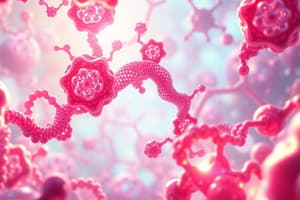Podcast
Questions and Answers
What is the primary function of enzymes in living organisms?
What is the primary function of enzymes in living organisms?
- To slow down chemical reactions
- To alter chemical reactions
- To consume chemical reactions
- To speed up chemical reactions (correct)
What is the characteristic that allows enzymes to catalyze only one specific reaction or a small group of related reactions?
What is the characteristic that allows enzymes to catalyze only one specific reaction or a small group of related reactions?
- High efficiency
- Reversible inhibition
- High specificity (correct)
- Optimal temperature and pH
Which type of enzyme catalyzes the formation of new chemical bonds?
Which type of enzyme catalyzes the formation of new chemical bonds?
- Oxidoreductases
- Hydrolases
- Ligases (correct)
- Transferases
What is the mathematical model that describes the kinetics of enzyme-catalyzed reactions?
What is the mathematical model that describes the kinetics of enzyme-catalyzed reactions?
What is the term for the maximum velocity of an enzyme-catalyzed reaction?
What is the term for the maximum velocity of an enzyme-catalyzed reaction?
What is the type of enzyme regulation that involves the binding of effectors to allosteric sites?
What is the type of enzyme regulation that involves the binding of effectors to allosteric sites?
What is the term for the inhibition of an enzyme by the product of a reaction?
What is the term for the inhibition of an enzyme by the product of a reaction?
What is the modification of an enzyme through covalent bonds, which can either activate or inhibit enzyme activity?
What is the modification of an enzyme through covalent bonds, which can either activate or inhibit enzyme activity?
Flashcards are hidden until you start studying
Study Notes
Enzymology: Definition and Overview
- Enzymology is the study of enzymes, which are biological molecules (proteins or RNA) that speed up chemical reactions in living organisms.
- Enzymes act as catalysts, increasing the rates of chemical reactions without being consumed or altered in the process.
Characteristics of Enzymes
- High specificity: Enzymes are highly specific, meaning they only catalyze one specific reaction or a small group of related reactions.
- High efficiency: Enzymes can speed up reactions by a factor of 10^6 to 10^12, making them highly efficient.
- Optimal temperature and pH: Enzymes have optimal temperatures and pH ranges at which they are most active.
- Reversible inhibition: Enzymes can be inhibited by reversible inhibitors, which bind to the active site or allosteric site, reducing enzyme activity.
Types of Enzymes
- Oxidoreductases: catalyze oxidation and reduction reactions
- Transferases: catalyze the transfer of functional groups between molecules
- Hydrolases: catalyze the hydrolysis of chemical bonds
- Ligases: catalyze the formation of new chemical bonds
- Isomerases: catalyze the rearrangement of molecules
- Lyases: catalyze the cleavage of various chemical bonds
Enzyme Kinetics
- Michaelis-Menten equation: a mathematical model describing the kinetics of enzyme-catalyzed reactions
- Vmax: the maximum velocity of an enzyme-catalyzed reaction
- Km: the Michaelis constant, which represents the enzyme's binding affinity for the substrate
Enzyme Regulation
- Allosteric regulation: the binding of effectors to allosteric sites, which can either activate or inhibit enzyme activity
- Feedback inhibition: the inhibition of an enzyme by the product of a reaction, which helps to regulate the amount of product formed
- Covalent modification: the modification of an enzyme through covalent bonds, which can either activate or inhibit enzyme activity
Enzymology: Definition and Overview
- Enzymes are biological molecules (proteins or RNA) that speed up chemical reactions in living organisms without being consumed or altered in the process.
Characteristics of Enzymes
- Enzymes have high specificity, meaning they only catalyze one specific reaction or a small group of related reactions.
- Enzymes can speed up reactions by a factor of 10^6 to 10^12, making them highly efficient.
- Enzymes have optimal temperatures and pH ranges at which they are most active.
- Enzymes can be inhibited by reversible inhibitors, which bind to the active site or allosteric site, reducing enzyme activity.
Types of Enzymes
- Oxidoreductases catalyze oxidation and reduction reactions.
- Transferases catalyze the transfer of functional groups between molecules.
- Hydrolases catalyze the hydrolysis of chemical bonds.
- Ligases catalyze the formation of new chemical bonds.
- Isomerases catalyze the rearrangement of molecules.
- Lyases catalyze the cleavage of various chemical bonds.
Enzyme Kinetics
- The Michaelis-Menten equation is a mathematical model describing the kinetics of enzyme-catalyzed reactions.
- Vmax is the maximum velocity of an enzyme-catalyzed reaction.
- Km is the Michaelis constant, which represents the enzyme's binding affinity for the substrate.
Enzyme Regulation
- Allosteric regulation involves the binding of effectors to allosteric sites, which can either activate or inhibit enzyme activity.
- Feedback inhibition involves the inhibition of an enzyme by the product of a reaction, which helps to regulate the amount of product formed.
- Covalent modification involves the modification of an enzyme through covalent bonds, which can either activate or inhibit enzyme activity.
Studying That Suits You
Use AI to generate personalized quizzes and flashcards to suit your learning preferences.




